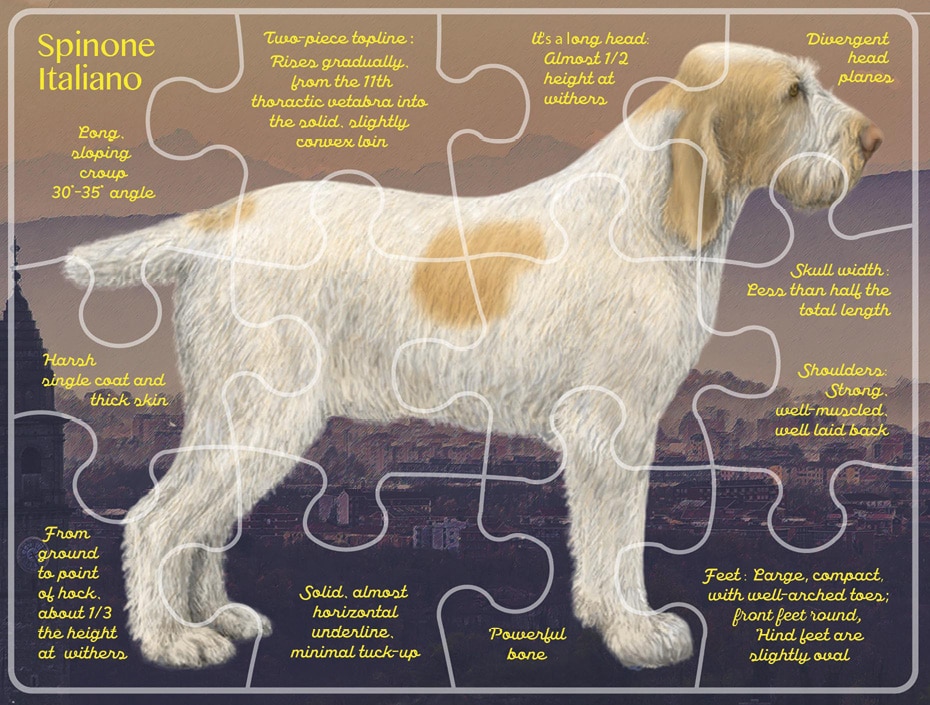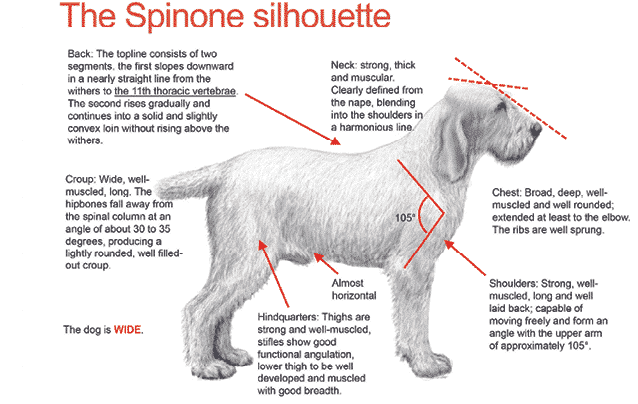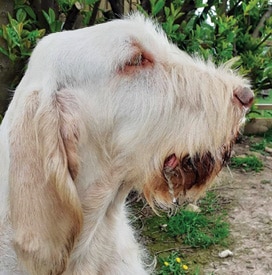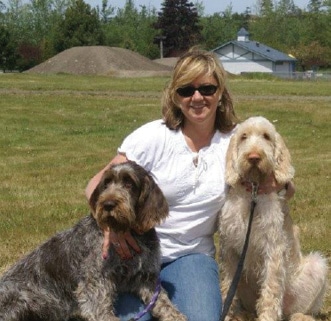
Home » The Spinone Italiano – A Well-Made Puzzle

Everyone has a unique and strategic world view, and this affects how each of us evaluates a dog. Some will evaluate dogs according to their show wins or losses. Others will evaluate dogs according to their own eye and how they think the dogs demonstrate (or not) the AKC standard, and might dismiss any show record as completely irrelevant. Some have seen a breed in many different countries, while others have only seen a breed in the United States, so there are always variations in “eye” and education. Some will pay special attention to judges who have made a particular study of their breed, while giving less weight to the opinions of judges who take a more generic approach.
Some fault judge or judge the dogs on a particular characteristic, while others judge the whole dog, looking at type more than faults. Each individual has a level of (or lack of) self-awareness and objectivity as they assimilate the information they have been given, by their own research or by way of a mentor, a breeder, or a particular authority on a dog breed.
We may struggle with our emotions playing too much of a role in our evaluation of our dogs and others’ dogs, but we do our best to look at the dog itself and to look at the whole dog.However we do it, we rely on these evaluations to help us make the right choices in our breeding programs for the preservation and improvement of our breed. The independent evaluation of phenotype that the show ring supports can be an important tool, which we use in addition to our knowledge of the genetic material that is expressed in our dogs’ ancestors and offspring.
We prefer to look at the Spinone Italiano as a puzzle. All of the pieces are important, and they all fit together to make the whole dog. Looking at one piece of a dog, and eliminating the dog from consideration or elevating it for only a single characteristic (barring DQs defined in the standard), is not the best way to approach this breed.

The first element of the puzzle is the general construction of the dog, and for this, we need to consider the environment that contributed to the origin of the breed. The Spinone Italiano was originally bred to hunt birds and small game in the mountains and the marshes of Italy’s Piemonte region. This steep, rough terrain requires a solid, sturdy, methodical hunter that doesn’t balk at heavy cover and has the stamina to work until there’s something for supper. The Spinone’s conformation lets it move through difficult terrain without wasting energy, at a powerful, purposeful trot, not a gallop.

Trotters and gallopers are not built the same. A sighthound is built to run great distances at high speed. You will see some of the sighthound’s characteristics in those pointing breeds bred to work in grass fields (many originated from England). Compare them with the Spinone Italiano, a dog built and bred to work in rough, uneven terrain and heavy brush or brambles. Its big feet serve a purpose!
AKC often encourages us to give judges three important points to remember, so they can judge the breed more easily. For a number of reasons, we do not believe this is a good approach for the Spinone Italiano. Divergent head plans, a two-piece topline, and a sloping croup are three hallmarks of this breed, and are essential. However, if that is all we know, we have covered only about a quarter of the dog. Coat type is also essential. The Spinone Italianohas a harsh coat and a thick skin that protects it from cold water and thorns—there is no undercoat. The coat is one-and-a-half to two-and-a-half inches long, and it is never groomed in a pattern or scissored, only hand stripping is used.

The Spinone Italiano is a wide dog. It should be almost square, with substantial bone, big feet, well-sprung ribs, and most of all, the very distinctive and telling soft expression that only a Spinone can have. The hind assembly is unique. The hock is 1/3 the height of the withers, and the angles at both front and rear are not as extreme as in many other Sporting dogs. The underline should have minimal tuck-up. Remember, the Spinone Italiano is a trotter, not a galloper.
Our AKC standard has a huge section on the head. There is, however, only one sentence about divergent head planes, which are essential to the breed. The rest of the section is devoted to all the other features of the head, including the skull shape (oval), the eye shape and set, the expression, the stop, the length and depth of the muzzle, the ear set and structure, the occiput, and more. All of these details, together, make the Spinone Italiano head. It’s easy to identify divergent planes on the fly; this characteristic is absolutely identifiable. It is essential to the Spinone and it’s important. But so is everything else the standard says about the head.
The proportions of the Spinone Italiano are vital, as they are for every breed. There are a number of essential proportions for the head. Among them, the skull is longer than it is wide, and the head’s length is 4/10 (that’s almost half) the height at the withers.
“The skull is oval with sides gently sloping from the sagittal suture in a curve to the zygomatic arch. Cheeks are lean.” It is crucial to consider all the elements of the skull shape when evaluating the Spinone Italiano. This doesn’t mean that a dog lacking a perfectly oval skull should not be a champion or a breeding dog, it just means that you know it is there and that you’ve considered it in your evaluation of this slightly complicated dog. Sometimes it is hard to understand what we mean by oval, but it becomes clear when you see it on a live dog.
Never forget to judge the whole midsection. The Spinone Italiano must have a two-piece topline as described in the standard, but the underline is equally important. Minimal tuck-up means exactly that. “The chest should be broad, deep, well-muscled and well rounded, extending at least to the elbow.” (The emphasis is mine.) Judges (and breeders and owners) should avoid picking just a single characteristic that they know about the breed, and instead take a whole-dog approach. This should include an understanding of the Spinone’s silhouette.
What about size? Our dogs do not have a size DQ. The size range for both males and females is considerable. Males can be 23.5 to 27.5 inches at the withers, and females can be 22.5 to 25.5. That is a 4-inch size range for males, and the variation can be striking in the ring. While breeders may have a preference for Spinoni at one end or the other of the standard’s range, both are acceptable. Over or under the specified height is considered a fault like every other fault, and a part of our evaluation.
We do not have enough space here to write more. However, we will leave you with these photos and labels, and we will let you decide why we picked these specific photos to show you! Thank you for your interest in the wonderful, rustic, charming, and hard-working Spinone Italiano. Please don’t hesitate to contact the Spinone Club of America’s Judges Education Committee if you have any questions: SCOAJudgesEd@gmail.com.
